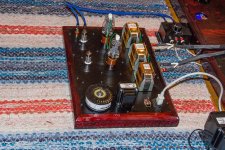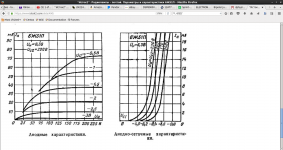Oops, I misunderstood, my apologies. I was wondering how much current would be pulled through the screens...40mA seemed like a lot to me... I didn't think 807's used that much.
Although, I do the triode strapping and admit I do not know pentode operation as much as I should.
Although, I do the triode strapping and admit I do not know pentode operation as much as I should.
I'm running VR tubes on the 4 807 screens. VR is fed 35mA, and they do not cut off. No sonic nasties nor flashes/reignition whatsoever.
However, I did experience that the effect of VR tubes drastically improve by allowing them plenty of current reserve, as the more current they have to regulate, the worse their regulation is. If you have plenty of current to burn and tons of chassis space I'd recommend separate VR tubes for each screen, and run them quite hot, about 32mA each. Thus, you'll need a constant 128mA supply for the screens alone, and chassis space for 8 VR tubes! But you'll be rewarded with dynamics off the charts.
However, I did experience that the effect of VR tubes drastically improve by allowing them plenty of current reserve, as the more current they have to regulate, the worse their regulation is. If you have plenty of current to burn and tons of chassis space I'd recommend separate VR tubes for each screen, and run them quite hot, about 32mA each. Thus, you'll need a constant 128mA supply for the screens alone, and chassis space for 8 VR tubes! But you'll be rewarded with dynamics off the charts.
Let me reveal one more secret: in my amps with 800V B+ and 270V G2 I use G2 current to control anti-clipping input optical attenuator. ;-)
Does that mean you have an optocoupler, consisting of a light bulb that is in series with the screen supply line, and a LDR as the bottom part of an input voltage divider?
just see how BOUYER do, one VR in serie no resistor needed for 2 6L6GC screen phase inverted
This is not a voltage regulator, but provides a (more or less) constant voltage drop from B+ to the screens instead.
Btw, I've seen the same in the amplifiers of Leslie rotating speaker cabinets.
Best regards!
Does that mean you have an optocoupler, consisting of a light bulb that is in series with the screen supply line, and a LDR as the bottom part of an input voltage divider?
Yes, but a pair of LEDs, not a bulb, in parallel with a trimpot to set current threshold. The second LED is used for overload indication.
https://www.youtube.com/watch?v=59UdNls-7oo
I am listening to the 807 -->6J51P amp with anode anode feedback, I just built.
Trying to compare it with my EL36SE amp,I think the 807 is as good or even better...🙂
It is a little brighter in a good way.I havent done any mesaurements yet,as I am rebuilding my PC.
Oh the driver is Pentode mode.
It is brighter but it also have deep bass.
Attachments
Last edited:
Very nice job on the chassis Ake!
I'm also driving my 807 with pentode (6SD7GT). When the driver is in pentode mode the sound brighter compared to triode connection. If the brightness is too much, you can try the driver in triode mode;
Janos
I'm also driving my 807 with pentode (6SD7GT). When the driver is in pentode mode the sound brighter compared to triode connection. If the brightness is too much, you can try the driver in triode mode;
Janos
If I decide to try triodemode,can I still use the anode to anode feedback then?
Yes, you can still use it. Gain of the driver will be different, so feedback level might change. You'll see if for the better or not ;
Do you can assign the various transformers?I am listening to the 807 -->6J51P amp with anode anode feedback, I just built.
The transformers are Lundahls,the opt are LL1663 the choke are LL1673 and then theres a choke from hammond the black tall one.
Is from Transformatory toroidalne - Producent transformatorow Toroidy.pl custommade.
At first I planned to use the 807 triodconnected so I wind the trafo for about 500v DC but now I´m using 350v tetrode mode (250v g2).So i´m using a very small (2uF) cap before choke 1,so i get about 350v under load.
At first I planned to use the 807 triodconnected so I wind the trafo for about 500v DC but now I´m using 350v tetrode mode (250v g2).So i´m using a very small (2uF) cap before choke 1,so i get about 350v under load.
I triodconnected the 6J51P but the sound was to dark and lifeless,so I thought I try the 6P15P triodconnected,I know people talked about it before in this thread I think.
And to my surprise it sounds quite good!The inputsensetivity is lower but I will manage.I have not yet decided if I should try it in pentodemode...
The anode to anode feedback is now 150K.
And to my surprise it sounds quite good!The inputsensetivity is lower but I will manage.I have not yet decided if I should try it in pentodemode...
The anode to anode feedback is now 150K.
I triodconnected the 6J51P but the sound was to dark and lifeless,so I thought I try the 6P15P triodconnected,I know people talked about it before in this thread I think.
And to my surprise it sounds quite good!The inputsensetivity is lower but I will manage.I have not yet decided if I should try it in pentodemode...
The anode to anode feedback is now 150K.
6J51P wants more voltage, 6P15P can deliver more of linear current. Actual load is anode load resistor in parallel with input resistance of the output stage that in your case is 150k divided by voltage amplification factor of your output stage. You do not want low non-linear internal resistance of the driver tube in triode mode to be effectively in parallel with the anode resistor that is in the voltage divider for the local feedback loop, so better use it in pentode mode.
...you are coming close to my Edelweiss design. ;-)
I am now using 6P15P in pentodemode,its good but not the best,the treble is to low..
When I tried 6J51P I forgott that I have a potentiometer on the treblespeaker to use...
Else I have the 6J49P any one tried it?
How much does it want?I belive I used about 170v...6J51P wants more voltage
When I tried 6J51P I forgott that I have a potentiometer on the treblespeaker to use...
Else I have the 6J49P any one tried it?
I am now using 6P15P in pentodemode,its good but not the best,the treble is to low..
Is the frequency response OK ? Have you measured it ?
- Home
- Amplifiers
- Tubes / Valves
- 807 Sound Quality?


